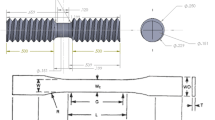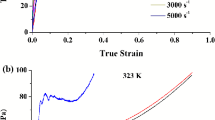Abstract
The brittleness of polystyrene (PS) and the toughness but notch sensitivity of polycarbonate (PC) have been studied by the detailed finite element analyses of the stress and strain fields in a notched tensile bar with a minor defect. The defect represented a flaw or imperfection, generated during the test specimen production. The large-strain mechanical responses of both materials were approximated by an accurate elasto-viscoplastic constitutive model with appropriate material parameters. It was assumed that failure occurs instantaneously once the dilative stress exceeds a certain critical craze-initiation stress. The analyses show that the unstable post-yield mechanical response of both materials results in localisation of stresses and strains near the defect at a very low macroscopic strain (0.16%). As a result, a strong dilative stress concentration is formed just below the surface of the defect. For the polystyrene specimen, the critical stress is reached at the defect. For the polycarbonate, however, the effect of the stress concentrating defect was counteracted by a higher craze-initiation stress and stronger strain hardening. The PC craze-initiation resistance, however, did not suffice to overcome the dilative stress concentration raised by the notch tip.
Similar content being viewed by others
References
E. J. Kramer, in “Adv. in Polymer Sci., Vol. 52/53,” edited by H. H. Kausch (Springer-Verlag, Berlin, 1983) Ch. 1.
C. S. Henkee and E. J. Kramer, J. Polym. Sci. Polym. Phys. Ed. 22 (1984) 721.
E. J. Kramer and L. L. Berger, in “Adv. in Polymer Sci., Vol. 91/92,” edited by H. H. Kausch (Springer-Verlag, Berlin, 1990) Ch. 1.
R. A. W. Fraser and I. M. Ward, J. Mater. Sci. 12 (1977) 459.
M. C. M. Van der sanden, J. M. M. Kok and MEIJER, Polymer 35 (1994) 2995.
M. C. M. Van der sanden, L. G. C. Buijs, F. O. De bie and H. E. H. Meijer, ibid. 35 (1994) 2783.
M. C. M. Van der sanden, H. E. H. Meijer and P. J. Lemstra, ibid. 34 (1993) 2148.
B. J. P. Jansen, H. E. H. Meijer and P. J. Lemstra, Polymer, submitted.
A. M. L. MagalhÃes and R. J. M. Borggreve, Macromolecules 28 (1995) 5841.
D. H. Ender and R. D. Andrews, Polymer Letters 36 (1965) 3057.
T. A. Tervoort, PhD thesis, Eindhoven University of Technology, Eindhoven, The Netherlands, 1996.
B. J. P. Jansen, PhD thesis, Eindhoven University of Technology, Eindhoven, The Netherlands, 1998.
R. J. M. Smit, W. A. M. Brekelmans and H. E. H. Meijer, Comput. Methods Appl. Mech. Engrg. 155 (1998) 181.
W. A. M. Brekelmans Idem., J. Mech. Phys. Solids 47 (1999) 201.
W. A. M. BrekelmanS Idem., J. Mater. Sci. 35 (2000) 2869.
W. A. M. Brekelmans Idem., ibid. 35 (2000) 2881.
O. A. Hasan, M. C. Boyce, X. S. Li and S. Berko, J. Polymer Sci.: Part B: Polymer Phys. 31 (1993) 185.
P. H. M. Timmermans, PhD thesis, Eindhoven University of Technology, Eindhoven, The Netherlands, 1997.
T. A. Tervoort, R. J. M. Smit, W. A. M. Brekelmans and L. E. Govaert, Mech. of Time Dep. Mat. 1 (1997) 269.
M. C. Boyce, D. M. Parks and A. S. Argon, Mechanics of Materials 7 (1988) 15.
D. M. Parks and A. S. Argon Idem., Int. J. Plasticity 5 (1989) 593.
E. M. Arruda and M. C. Boyce, ibid. 9 (1993) 697.
P. D. Wu and E. Van der giessen, ibid. 35 (1993) 935.
T. A. Tervoort, E. T. J. Klompen and L. E. Govaert, J. Rheol. 40 (1996) 779.
A. I. Leonov, Rheol. Acta 15 (1976) 85.
F. P. T. Baaijens, ibid. 30 (1991) 284.
Marc, “Programmer and User Manuals” (MARC Analysis Research Corporation, Palo Alto, CA, USA, 1997).
R. J. M. SMIT, W. A. M. BREKELMANS and F. P. T. BAAIJENS, Int. J. Numer. Methods Engrg., submitted.
G. M. Gusler and G. B. Mckenna, Polym. Eng. Sci. 37 (1997) 1442.
L. E. Govaert and T. Peijs, Mech. of Time Dep. Mat., submitted.
M. Ishikawa, H. Ogawa and I. Narisawa, J. Macromol. Sci.-Phys. B19 (1981) 421.
I. Narisawa and A. F. Yee, in “Materials Science and Technology. A Comprehensive Treatment, Vol. 12,” edited by E. L. Thomas (VCH, Weinheim, 1993) p. 699.
I. Narisawa, M. Ishikawa and H. Ogawa, J. Mater. Sci. 15 (1980) 2059.
R. Hill, “The Mathematical Theory of Plasticity” (Oxford Univ. Press, London, 1950).
R. P. Nimmer and J. T. Woods, Polym. Eng. Sci. 32 (1992) 1126.
L. E. Govaert and T. A. Tervoort, in Proc. 9th Int. Conf. Def., Yield and Fracture of Polymers, Churchill College, Cambridge (The Institute of Materials, London, 1994) P67/1.
C. J. G. Plummer and A. M. Donald. J. Polym. Sci. Polym. Phys. Ed. 27 (1989) 325.
M. Ishikawa, Y. Sato and H. Higuchi, Polymer 37 (1996) 1177.
S. Havriliak, C. A. Cruz and S. E. Slavin, Polym. Eng. Sci. 36 (1996) 2327.
J. C. Simo, in “Cracking and Damage: Strain Localization and Size Effect,” edited by J. Mazars and Z. P. Bažant (Elsevier, London 1989) p. 440.
J. Lai and E. Van der giessen. Mechanics of Materials 25 (1997) 183.
Author information
Authors and Affiliations
Rights and permissions
About this article
Cite this article
Smit, R.J.M., Brekelmans, W.A.M. & Meijer, H.E.H. Predictive modelling of the properties and toughness of polymeric materials Part I Why is polystyrene brittle and polycarbonate tough?. Journal of Materials Science 35, 2855–2867 (2000). https://doi.org/10.1023/A:1004711622159
Issue Date:
DOI: https://doi.org/10.1023/A:1004711622159




